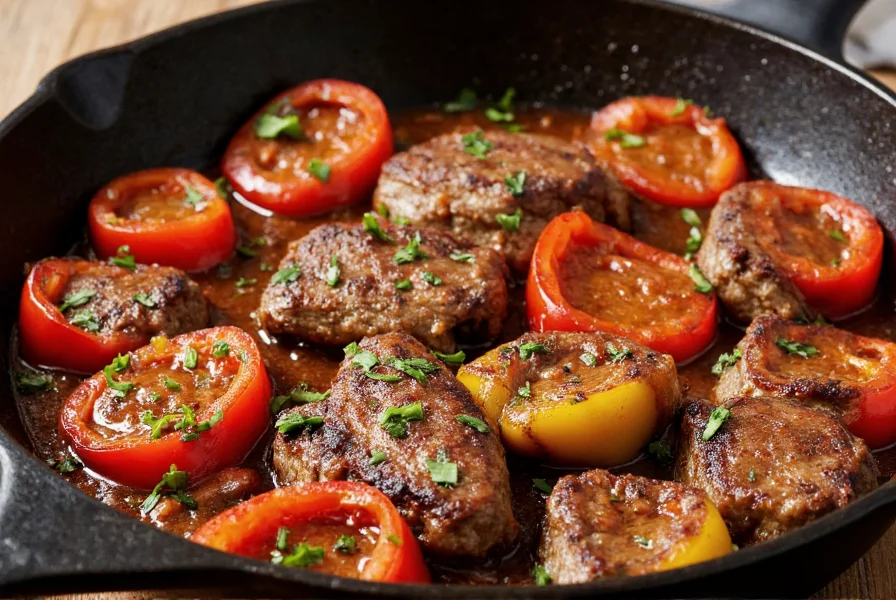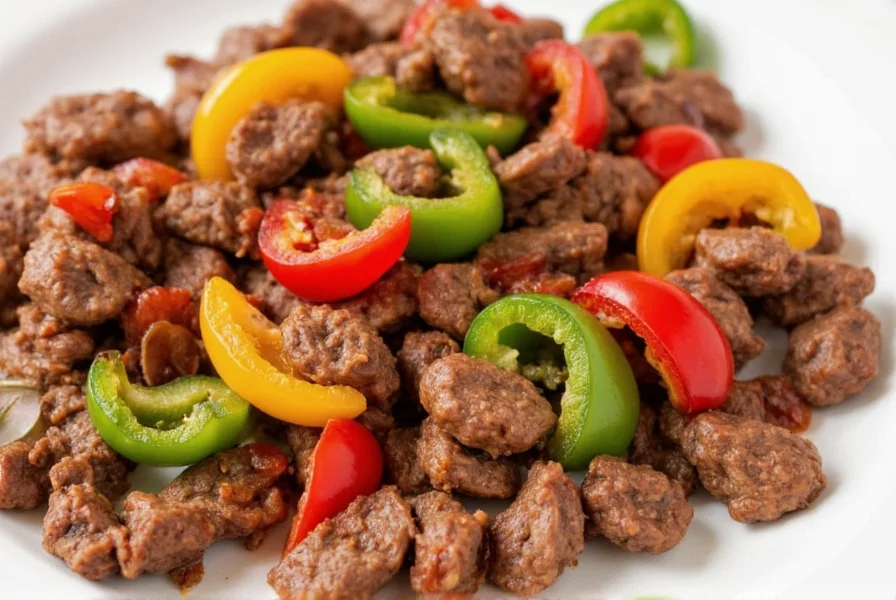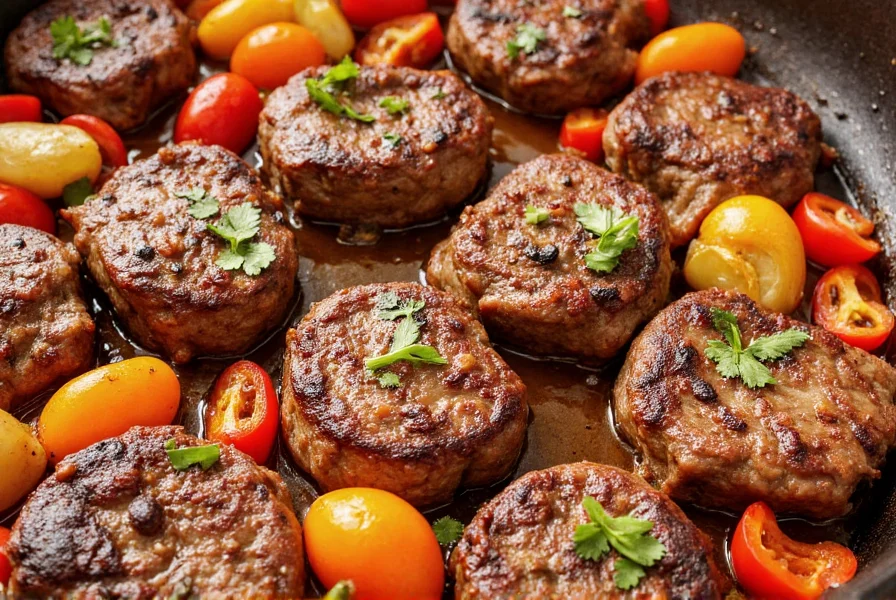Pepper steak is a classic stir-fry dish featuring tender strips of beef and colorful bell peppers in a savory sauce. The three most reliable methods for making exceptional pepper steak at home are: the traditional Chinese-American stir-fry technique, a quick weeknight version using pre-sliced ingredients, and a gourmet restaurant-style preparation with premium cuts and homemade sauce. Each method requires proper searing technique, sauce balance, and timing to achieve the perfect texture and flavor.
When you're craving that perfect combination of tender beef and crisp bell peppers in a rich, savory sauce, nothing satisfies like a well-executed pepper steak recipe. This beloved dish has evolved from its Chinese-American restaurant origins to become a staple in home kitchens worldwide. Whether you're a beginner cook or an experienced home chef, mastering pepper steak requires understanding the essential techniques that transform simple ingredients into something extraordinary.
Understanding Pepper Steak: More Than Just a Stir-Fry
Pepper steak isn't just random strips of beef and peppers thrown together—it's a carefully balanced dish where technique matters as much as ingredients. The magic happens through proper high-heat searing, sauce emulsification, and precise timing. Unlike many stir-fries, authentic pepper steak features a glossy, clinging sauce that coats each piece of meat without making it soggy.

Essential Ingredients and Why They Matter
The beauty of pepper steak lies in its simplicity, but each component plays a critical role:
| Ingredient | Function | Pro Tip |
|---|---|---|
| Flank or sirloin steak | Provides tender texture when sliced properly | Freeze for 20 minutes before slicing for cleaner cuts |
| Fresh bell peppers | Offers sweetness and crisp texture | Use multiple colors for visual appeal and flavor complexity |
| Garlic and ginger | Creates aromatic foundation | Mince finely to distribute flavor evenly |
| Soy sauce and oyster sauce | Builds umami-rich base | Use premium brands for better flavor depth |
| Cornstarch slurry | Creates signature glossy sauce | Mix with cold water before adding to hot pan |
Three Proven Pepper Steak Recipes for Every Occasion
1. Classic Chinese-American Pepper Steak (Restaurant Style)
This version replicates the beloved takeout favorite with techniques that guarantee authentic results. The key is velveting the meat before stir-frying, which creates that distinctive tender texture.
Ingredients:
- 1.5 lbs flank steak, sliced against the grain
- 3 bell peppers (mixed colors), sliced
- 3 cloves garlic, minced
- 1 tbsp fresh ginger, minced
- 3 tbsp soy sauce
- 2 tbsp oyster sauce
- 1 tbsp Shaoxing wine
- 1.5 tbsp cornstarch
- 2 tbsp vegetable oil
Instructions:
- Combine steak with 1 tbsp soy sauce, 1 tbsp cornstarch, and 1 tbsp Shaoxing wine. Marinate 20 minutes.
- Heat 1 tbsp oil in wok until smoking. Sear steak in single layer (don't overcrowd), 1-2 minutes per side. Remove.
- Add remaining oil, stir-fry peppers until crisp-tender (2-3 minutes).
- Return steak to wok, add garlic and ginger, stir 30 seconds.
- Pour in remaining sauce ingredients. Cook until sauce thickens and coats ingredients (1-2 minutes).
2. Quick Weeknight Pepper Steak (30-Minute Version)
When time is limited but you still want restaurant-quality results, this streamlined method delivers. The secret is strategic ingredient preparation before heating your pan.
Mix 2 tbsp soy sauce, 1 tbsp brown sugar, 1 tbsp rice vinegar, 1 tsp sesame oil, and 1.5 tbsp cornstarch with ¼ cup water. Heat 2 tbsp oil in large skillet over high heat. Cook 1 lb pre-sliced sirloin in batches until browned (90 seconds per batch). Remove. Add sliced peppers and onions, stir-fry 3 minutes. Return beef to pan, pour sauce over, and cook until thickened (60-90 seconds). Garnish with sesame seeds.

3. Gourmet Pepper Steak with Premium Ingredients
Elevate your pepper steak with chef-inspired techniques and high-quality components. This version uses homemade sauce and dry-aged beef for exceptional depth of flavor.
Combine 3 tbsp tamari, 2 tbsp homemade beef demi-glace, 1 tbsp hoisin, 1 tbsp mirin, and 1.5 tsp cornstarch. Sear 1.5 lbs dry-aged ribeye (sliced ¼ inch thick) in avocado oil. Remove. Sauté multi-colored peppers and shallots until caramelized. Deglaze pan with 2 tbsp Shaoxing wine. Return beef, add sauce, and finish with a touch of black bean garlic sauce. Serve over jasmine rice with scallion garnish.
Critical Techniques for Perfect Pepper Steak Every Time
Achieving restaurant-quality pepper steak at home requires attention to specific details that most recipes overlook:
- Slicing against the grain - Cut perpendicular to muscle fibers for maximum tenderness
- Proper heat management - Wok must be smoking hot before adding ingredients
- Sauce consistency - Should coat the back of a spoon but still flow slightly
- Ingredient sequencing - Cook components separately then combine at the end
- Resting time - Let meat rest 5 minutes after cooking for juicier results
Common Pepper Steak Mistakes and How to Avoid Them
Even experienced cooks make these critical errors when preparing pepper steak recipes:
- Overcrowding the pan - Leads to steaming instead of searing (cook in batches)
- Using wet ingredients - Water prevents proper browning (pat meat and peppers dry)
- Adding cornstarch directly - Creates lumps (always make a slurry first)
- Overcooking the peppers - They should remain crisp (add later in cooking process)
- Using low-quality soy sauce - Brands matter for authentic flavor (avoid cheap alternatives)
Serving Suggestions and Perfect Pairings
Pepper steak shines when served with complementary sides that balance its rich flavors:
- Steamed jasmine rice (absorbs sauce beautifully)
- Simple cucumber salad with rice vinegar
- Garlic green beans for added vegetable content
- Hot and sour soup as a starter
- Cold Asian beer or Riesling wine to cut through richness
Storage and Reheating for Best Results
While pepper steak is best enjoyed fresh, proper storage maintains quality for leftovers:
- Cool completely before storing in airtight container
- Refrigerate for up to 3 days or freeze for 2 months
- Reheat gently in skillet with 1 tsp water to revive sauce
- Avoid microwave reheating (makes meat tough and peppers soggy)
- Add fresh scallions after reheating for brightness
Frequently Asked Questions
What's the best cut of beef for pepper steak recipes?
Flank steak and sirloin are ideal for pepper steak due to their flavor and ability to remain tender when sliced properly. For premium results, use dry-aged ribeye cut ¼ inch thick against the grain. Avoid tougher cuts like chuck that don't respond well to quick cooking methods.
How can I make my pepper steak sauce thicker without lumps?
The secret to lump-free thickening is creating a proper cornstarch slurry. Mix 1.5 tablespoons cornstarch with ¼ cup cold water until completely smooth, then pour into the simmering sauce while stirring constantly. The sauce should thicken within 60 seconds. Never add dry cornstarch directly to hot liquid.
Why does my homemade pepper steak never taste like restaurant version?
Restaurant pepper steak benefits from professional equipment that achieves much higher temperatures than home stovetops. To replicate this, ensure your pan is smoking hot before adding ingredients, work in small batches to avoid temperature drops, and consider using a cast iron skillet or carbon steel wok which retains heat better than non-stick alternatives.
Can I make pepper steak gluten-free?
Yes, easily make gluten-free pepper steak by substituting tamari for soy sauce and ensuring your oyster sauce is gluten-free (or use mushroom sauce as alternative). Most cornstarch is naturally gluten-free, but verify your brand if you have severe sensitivities. The cooking technique remains identical to traditional recipes.
How do I prevent my peppers from becoming soggy in pepper steak?
To maintain crisp-tender peppers, slice them uniformly and add them to the pan after the meat has been seared and removed. Stir-fry peppers over high heat for just 2-3 minutes until they brighten in color but still have bite. Overcooking is the primary cause of soggy peppers in homemade pepper steak recipes.











 浙公网安备
33010002000092号
浙公网安备
33010002000092号 浙B2-20120091-4
浙B2-20120091-4